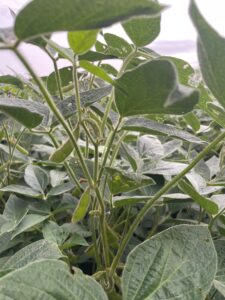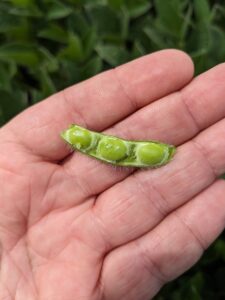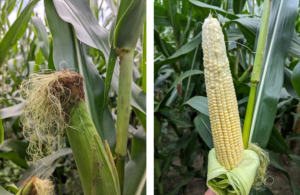Illinois Crop Update – August 9, 2024
Russ Higgins – Commercial Agriculture Educator
Grundy County
Soil Conditions: Mildly Dry (soil is drier than normal, plant growth may have slowed)
This week precipitation has been mixed in northeast Illinois, areas north of the Rte. 80 corridor have received multiple rainfall events while areas south have received limited to no precipitation. Soy continues to progress, reaching R5, beginning seed stage. Depending upon variety maturity and planting date, most corn fields visited were R3-R4 to R4-R5. An unwelcome discovery this week was significant Tar spot symptoms in several corn fields. The decision to use a fungicide treatment is difficult in later maturity stages, especially when we are near R5, the dent stage. A reminder that grain fill in the dent stage often extends to 30 days or more. However, with declining commodity prices farmers need to consider their ROI (return on investment) when considering a or additional fungicide applications. A tool available to aid in the decision making is the Corn Fungicide ROI Calculator from the Crop Protection Network. The purpose of the Corn Fungicide ROI Calculator is to share results from university uniform corn fungicide trials conducted in the United States and Canada and allow farmers and others in the agricultural industry to calculate the potential return on investment (ROI) for corn fungicide application across a variety of user-defined factors, which is based on research data included in this calculator. The two variables needed are expected corn yield and marketing price. The calculator can be accessed here.

Figure 1: Tar spot; Grundy County – Aug 6th, 2024

Figure 2: R5 Beginning seed soy – Aug 6th, 2024
Reagan Tibbs – Commercial Agriculture Educator
Logan County
Soil Conditions: Near Normal
Crops across Logan, Menard, and Sangamon counties continue to grow and develop nicely, thanks to last week’s rain showers. Despite having high winds during some storms, there does not appear to be any wind damage to the crops. Many soybean fields are in the R4 stage, with some earlier planted fields beginning to develop seeds (R5). Much of the same can be said for the corn crop as well. Most fields are in the R4 dough stage, with some of the earlier planted fields beginning to dent (R5). The alfalfa across the area has grown back nicely as well, with last week’s rains and this week’s cooler temperatures helping. Most fields look to be in Stage 3 (early bud).
Talon Becker – Commercial Agriculture Specialist
McLean County
Soil Conditions: Near Normal
This past week has brought some drier weather to east central Illinois than the week prior. In the eastern half of McLean County, soil moisture conditions looked good, overall, during my survey. Most fields have started to dry in the top couple of inches of the soil profile, but some parts of low-lying and/or poorly drained fields still had soils that were at field capacity. Compared to some of my surveys in recent weeks in neighboring counties, I saw very few soybean fields showing spots of plant stress due to waterlogging and/or soil-borne pathogens. A few of the corn fields I visited were showing early signs of stalk rot in some plants, although at this time, this seemed to be largely limited to those wetter fields I mentioned earlier. Something else I saw in several of these wetter corn fields was corn ears containing both brown, senesced silks and unpollinated silks. The tassels in these fields did not appear to be shedding any viable pollen, which may mean it’s too late for these silks/ovules to make grain. Most corn was in the late R3 (milk) to early R4 (dough) range, but I did find one field at early dent (R5) and another still at blister (R2). Soybeans ranged from R3 (beginning pod) to late R5 (beginning seed), with most falling in the latter half of that range.

Figure 3: Pod from soybean plant approaching full seed (R6)

Figure 4: Corn ear with unfertilized ovules at the ear tip





